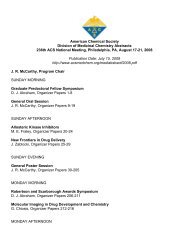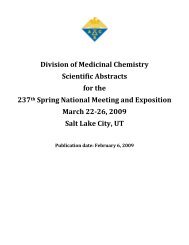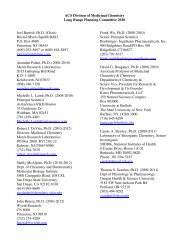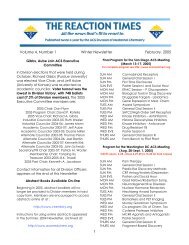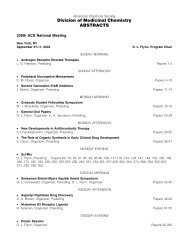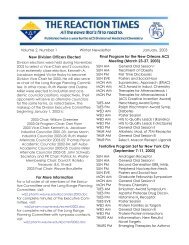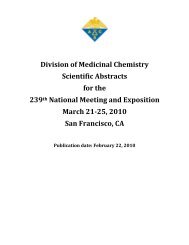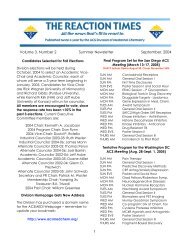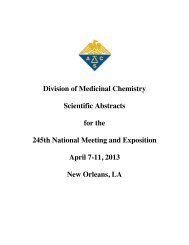Division of Medicinal Chemistry Abstracts-235th ACS National ...
Division of Medicinal Chemistry Abstracts-235th ACS National ...
Division of Medicinal Chemistry Abstracts-235th ACS National ...
- No tags were found...
You also want an ePaper? Increase the reach of your titles
YUMPU automatically turns print PDFs into web optimized ePapers that Google loves.
We synthesized E41, an antibiotic conjugated to a bisphosphonate, which binds CP, creating<br />
targeted drug delivery. E41 bound to bone-homeostatic CP and packed into traumatized bone,<br />
may prevent OM. We contrasted two CPs, µ-sized Skelite and nm-sized NanOss. Adult rats<br />
received traumatic open tibial fracture with medullary contamination by Staphylococcus aureus<br />
(Sa), lavage, E41-CPs packed into the defect, and sacrificed at day 1. Tibial loads, expressed<br />
as log10 colony-forming units/gm, were: Infection controls, 4.40±0.9, E41-Skelite, 2.70±2.0, and<br />
E41-NanOss, 1.10±1.3 (p≤0.01). E41-NanOss produced significantly lower tibial loads vs. E41-<br />
Skelite (p=0.001). Sixteen <strong>of</strong> 16 Infection-control tibiae yielded bacteria, with high tibial loads,<br />
suggesting developing acute OM; E41-NanOss group, 16 <strong>of</strong> 19 tibiae sterile vs. 5 <strong>of</strong> 18 for E41-<br />
Skelite (p=0.0005). NanOss appears to be a better carrier for E41, than Skelite, perhaps<br />
due to its higher particle surface area. E41-NanOss eradicated Sa infection in traumatized bone.<br />
MEDI 29<br />
First small molecule inhibitors <strong>of</strong> RecA in living bacteria<br />
Anna V. Gromova, Tim J. Wigle, and Scott F. Singleton, School <strong>of</strong> Pharmacy, <strong>Division</strong> <strong>of</strong><br />
<strong>Medicinal</strong> <strong>Chemistry</strong> and Natural Products, University <strong>of</strong> North Carolina, CB #7360, Chapel Hill,<br />
NC 27599, gromova@email.unc.edu<br />
Antibiotic resistance in bacteria is an escalating threat. RecA facilitates the development and<br />
transmission <strong>of</strong> antibiotic resistance genes, and promotes survival <strong>of</strong> bactericidal chemotherapy.<br />
We identified, synthesized, and tested several members <strong>of</strong> different classes <strong>of</strong> small molecules<br />
towards inhibition <strong>of</strong> the RecA protein. Initial leads came from high-throughput screening in<br />
collaboration with the BRITE Institute <strong>of</strong> North Carolina Central University. We report the first<br />
small molecules capable <strong>of</strong> inhibiting the bacterial SOS response in live bacteria resulting from<br />
exposure to Cipr<strong>of</strong>loxacin and appear to do so by inhibiting the RecA protein (IC50 < 10 µM).<br />
MEDI 30<br />
Methods for purifying and detoxifying sodium dodecyl sulfate-stabilized polyacrylate<br />
nanoparticles<br />
Julio Cesar Garay 1 , Danielle Gergeres 1 , Ashley Young 2 , and Edward Turos 1 . (1) Department <strong>of</strong><br />
<strong>Chemistry</strong>, University <strong>of</strong> South Florida, 4202 E.Fowler Ave., NES 330, Tampa, FL 33620,<br />
jgarayji@mail.usf.edu, (2) Department <strong>of</strong> <strong>Chemistry</strong>, student, Tampa, FL 33620<br />
The tremendous impact that antibiotics have had on human health is well-appreciated.<br />
However, many microorganisms have rapidly acquired resistance for most <strong>of</strong> the currently<br />
available antimicrobials, displaying an amazing versatility to overcome the cidal or static effects<br />
<strong>of</strong> antibiotics on microbial growth and proliferation. The continuing rise in the numbers and<br />
prevalence <strong>of</strong> drug-resistant microbes that cause infections, most notably methicillin-resistant<br />
Staphylococcus aureus (MRSA), is further exasperated by the sheer difficulty and expense <strong>of</strong><br />
developing new antimicrobially-active molecules. Moreover, many <strong>of</strong> the most promising drug<br />
candidates suffer from poor water solubility and systemic stability that limits their clinical<br />
development. Our laboratory has been working on ways to improve the performance <strong>of</strong> such<br />
antibiotic compounds, and for enhancing the activity <strong>of</strong> older classes <strong>of</strong> antibiotics, using<br />
polyacrylate nanoparticles. These nanoparticles can be easily prepared by emulsion



